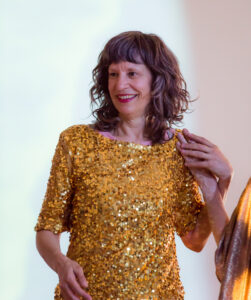
[ID: A 50 year-old white woman with dark hair cut in a shag, wearing a sequin gold top and bright red lipstick, smiles as she gazes over one shoulder, while gently cradling another dancer’s hand on her opposite shoulder. The photo is cropped from the elbows up against a white wall.]
“Life is fragile, handle with care.” So declared the tagline of a Dow Chemical safety campaign when I was growing up. Dad worked there as a safety engineer.
How do we engineer safety? What do we make spaces safe for? Who do we make spaces safe for?
Dow distributed shiny two-tone green stickers with nested figures: a little round figure inside a triangular figure inside a rectangular figure. We were told the sticker carried the message: Look out for your safety, and the safety and care of your community.
This issue of In Dance is dedicated to care. To unpacking what our art form and our community are experiencing and exploring when it comes to practicing and performing care. How have our views of care and safety evolved in recent years?
“The pandemic and its ‘bubble’ confinement logic gave us the sensation that safety lies in solitude and inactivity. But safety is not the same as care, which requires interdependence and the risk of contact. Relationality is key.”[1]
Think of this In Dance issue as a care package! Containing pieces on:
- Communication as care
- Aftercare
- Curation as care
- Dance company as care company
- Care for our past and future selves
- Care for the earth
- Care for immigrants
- Care for the archives
What is self-care, if relationality is key? There is a movement afoot to replace ‘caregiver’ with ‘care partner’ to shift the perspective, respect the care dynamic, represent reciprocity. But care too often becomes imbalanced. An estimated 43.5 million people in the United States provide unpaid care to an adult or a child.[2] Those providing care develop “caregiver burden,” a state of complete overwhelm as a consequence of isolating, exploiting or undercompensating.
If you happened to visit Dolores Park during the early part of the pandemic you would have seen white circles spray-painted all over the lawn. A micro-community sprang up inside each ‘safety bubble.’ Risking contact! To lift our own and each other’ spirits. Look inside these pages to see ample evidence of care in dance — pictures, rituals, jams — elevating and amplifying what’s right in front of us. Care that includes people at the edges. Care for every single life.
Carefully yours,

[1] Kristof Van Baarle, Felipe Cervera and Helena Grehan, “Stranger than Kindness,” Performance Research: On Care vol. 27, no. 6-7 (October/November 2022), 4.
[2] https://www.ncbi.nlm.nih.gov/pmc/articles/PMC8412180/
This article appeared in the Winter 2024 issue of In Dance.

